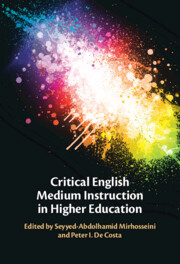Book contents
- Critical English Medium Instruction in Higher Education
- Critical English Medium Instruction in Higher Education
- Copyright page
- Contents
- Figures and Tables
- Contributors
- Foreword
- 1 Critical Views of English Medium Instruction
- Part I Ideologies and Educational Policies
- Part II Identity and Educational Justice
- 7 EMI Teachers’ Discourses and the Configuration of Their Identities in Two Colombian Universities
- 8 “I Just Opened My Heart”
- 9 Perpetuating Inequality in Higher Education EMI in Ethiopia, Poland, and Japan
- Part III The Politics of English in Education
- Afterword
- Index
- References
9 - Perpetuating Inequality in Higher Education EMI in Ethiopia, Poland, and Japan
from Part II - Identity and Educational Justice
Published online by Cambridge University Press: 31 January 2025
- Critical English Medium Instruction in Higher Education
- Critical English Medium Instruction in Higher Education
- Copyright page
- Contents
- Figures and Tables
- Contributors
- Foreword
- 1 Critical Views of English Medium Instruction
- Part I Ideologies and Educational Policies
- Part II Identity and Educational Justice
- 7 EMI Teachers’ Discourses and the Configuration of Their Identities in Two Colombian Universities
- 8 “I Just Opened My Heart”
- 9 Perpetuating Inequality in Higher Education EMI in Ethiopia, Poland, and Japan
- Part III The Politics of English in Education
- Afterword
- Index
- References
Summary
Inequality in higher education English Medium Instruction (EMI) is mainly discussed in Global South contexts, where socioeconomic status and rural–urban contrasts are often identified as the main drivers. In this chapter we present the situation of EMI inequalities in three very different national contexts – Ethiopia, Poland, and Japan – with provision of empirical evidence in support of arguments made. The authors have been involved in researching EMI in these contexts and issues of inequalities arose in our data as important concerns that should be discussed. In this chapter we promote the argument that, contrary to education ministries’ insistence, EMI may present limited opportunities or, where socioeconomic issues can be overcome, it may present new opportunities for marginalised populations in certain disciplines. We argue that EMI should not be heralded as a solution to any range of problems, emphasising that even across a range of socioeconomies EMI brings opportunities only for certain sectors of the population. We conclude with suggestions for how EMI might be used more effectively to achieve the goals it is often intended for.
Keywords
- Type
- Chapter
- Information
- Critical English Medium Instruction in Higher Education , pp. 146 - 162Publisher: Cambridge University PressPrint publication year: 2025

